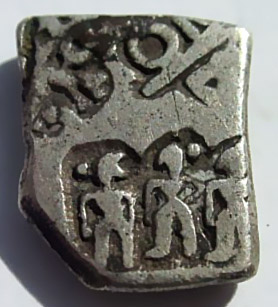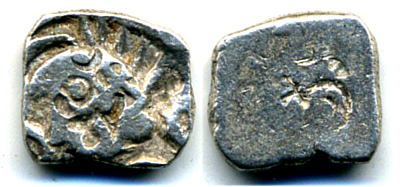 The fall of the Mauryan Empire, encouraged the principalities that were humbled under the imperial domination to come into power again and re-establish their administration: local, tribal and monarchical. These new states issued coins mostly in copper and silver.
The fall of the Mauryan Empire, encouraged the principalities that were humbled under the imperial domination to come into power again and re-establish their administration: local, tribal and monarchical. These new states issued coins mostly in copper and silver.
During this period, some coins were found at various places in Bihar. The coins were square or rectangular dumpy copper pieces about one and a half inches and three quarters of an inch wide. These were punched with five bold symbols on one side of the coin and four on the other. The groups of five symbols closely resemble the earlier silver punch marked coins of the Mauryan period. Those coins were different in fabric and most likely were issued by Pushyamitra Sunga (who usurped the Mauryan throne in about 184 B.C). His successors had shifted to Vidisa from where punch marked copper coins were issued. Those punch marked coins were flat board pieces about an inch in size. They bore four or five neat symbols on one side of the coin and the other side remained blank. On a few coins of these series one of the symbols was found replaced by a legend bearing the names of their issuers. The third type of copper coin bore only one or two symbols and some of the copper punch marked coins resemble the Mauryan silver punch marked coins.
The other coins of post Mauryan period were either produced from moulds which were struck from dies. The moulding technique was employed for copper coins in the Mauryan period and the latter technique was introduced during the Indo-Bactrine period. Including these, a new element of inscription was added to most of the coins to denote the issuing authority. The earlier coins used symbols similar to those used on the punch marked coins but later those symbols were replaced by new devices of animals. The coins of Ujjain were of large variety and most of them had a single symbol which was popularly known as "Ujjain symbol". The symbol was defined with a circle at the top of each arm an din some cases it was doubled and in some coins the symbol of `Swastika`, taurine or the Ujjain symbol was placed within the circle. The obverse side of the coins had two to seven symbols, similar to those of the punch marked coins. But some of the coins of this time bore a striking figure of a standing man with a long stick. The figure was sometimes three headed and was identified as Shiva or Kartikeya. In some of the coins, a female figure was also observed and was considered as Lakshmi. In some cases the common Ujjain symbol was found replaced by a frog.
The inscribed coins of the Post Mauryan Empire may be identified as local or `nigam`, tribal or `Janapadas` or `Ganas` and monarchical or `Rajatantriya` issues from their inscriptions. The local coins bore the place name and were perhaps issued by some kind of city states. Some of the coins bore the devices of the coins of the king with his name on one side of the coin and the name of the city on the other side. Among the coins, one of the most interesting coins of the city states was that of Pushkalavati (modern Peshwar). Those coins were mainly small gold coins weighing 56 grains. One side of the coin was decked with a figure of a standing female wearing a crown and holding some object with the Kharoshthi inscription `Pukhalavadi devada Ampai` meaning Amba the goddess of Pushkalavati. The other side of the coin bore a humped bull with the word `Tauros` in Greek and `Ushabha` in Kharoshthi. The coin was Hellenistic in its fabric and style.
The coins of tribal republics are also included in the coins of Post Mauryan era. The tribal republics lot their independence during the imperial supremacy. After the break down of the Empire, they returned to their own republican system and issued their own coins. The Agreya, Kshudraka, Rajanya, Sibi, Trigarta and Yaudheya issued coins during the second century B.C. The coins of the early tribal republics of the second century B.C bore the names of the tribes and the places on the coins in the Brahmi scripts. The other republics had their names on the coins along with some personal name with the title `Raja` or `Maharaja` and also bore the name of their presiding deity. Each tribe carries a distinct weight for the coins. A number of tribes issued coins in more than one weight as multiples or sub multiples. A few tribes issued coins in silver also. Some copper coins issued in the Gandhara region bore the Brahmi inscription `Nekame`, a nominative plural, corresponding to the Sanskrit `Naigamah` on one side and the other side bore the names of `Ralimata`, `Atakataka`, or `Dojaka`. These coins were said that those coins were issued by the merchants or traders.
 The later coins of Surasena rulers bore symbols similar to those that used earlier for the punch marked coins and also included the figure of a standing female deity. The coins of the rulers of this community were `hemidrachm` of silver, highly debased with lead, and closely resemble the late issues of the Indo-Bactrian rulers, Strato I and II. The portrait on the obverse side of the coin bore the king facing to the right; the legend in blundered Greek gave his name with the title `Basileos Basilion Sotoros`. The reverse side of the coin had the Pallas Athene and the Kharoshthi legend. In the later period, the kingdom of Panchala issued as uniform series of copper coins bearing the names of no less than twenty one rulers. These coins carried three small symbols in a row and the name of the issuer below on one side of the coin. The other side of the coin bore a figure or symbol that represents the god or goddess, whose name forms part of the name of the ruler. Some coins from Panchala were known to be of a quite different series that show a wheel on one side and the name `Achyu` on the other side of the coin.
The later coins of Surasena rulers bore symbols similar to those that used earlier for the punch marked coins and also included the figure of a standing female deity. The coins of the rulers of this community were `hemidrachm` of silver, highly debased with lead, and closely resemble the late issues of the Indo-Bactrian rulers, Strato I and II. The portrait on the obverse side of the coin bore the king facing to the right; the legend in blundered Greek gave his name with the title `Basileos Basilion Sotoros`. The reverse side of the coin had the Pallas Athene and the Kharoshthi legend. In the later period, the kingdom of Panchala issued as uniform series of copper coins bearing the names of no less than twenty one rulers. These coins carried three small symbols in a row and the name of the issuer below on one side of the coin. The other side of the coin bore a figure or symbol that represents the god or goddess, whose name forms part of the name of the ruler. Some coins from Panchala were known to be of a quite different series that show a wheel on one side and the name `Achyu` on the other side of the coin.
The monarchical coins of Vatsa bore a bull with a symbol on one side and a tree in railing with some other symbols on the other, together with the name of the king. The coins with these devices were uniformly issued by the successive rulers. The rulers also retain some devices with a slight modification, but the fabric was quite different. A coin had been found that bore the name of Rudra on one side and Siva standing by the side of the bull on the other. These coins stand as evocative of the coins of Kushanas. The issuer of the coin, Rudra was Rudradeva who was mentioned in the inscription on the Allahabad Pillar. The monarchy of Kosala initially issued coins by the process of casting. Those coins had a bull or elephant on one side of the coin and the other side bore five or six symbols of the type used on the earlier punch marked coins. The later coins issued by the rulers were smaller in size and some coins showed an elephant on one side and an Abhisheka Lakshmi on the other side of the coin. Some of the coins were struck with slight modification during this time. A reference to copper punch marked coins from the Vidisa-Eran region, attributable to the later Sunga and Kanva rulers had been made earlier. These coins were later followed by the inscribed punch marked coins. A reference had also been made to a long series of the uninscribed die struck coins from the Ujjain region.
In Tripuri region, some uninscribed uni faced copper or bronze coins had been found and these coins displayed a standing human figure flanked by symbols. It had been said that these coins were issued after the declination of the Mauryas. During the second century A.D, the dynasty of the Nagas issued coins which were peculiarly small and bore the name of the king on one side in Brahmi and a symbol or an animal or bird on the other side of the coin. The figure of a humped bull was most commonly used on the coins and peacock was the most prominent bird among the other birds figured on the coins. In Mahakosala region arose the dynasties of the Mitras, Maghas, Senas and Bodhis. They also issued coins that had been found in archeological excavations.
The coins of the east, in Orissa, no coins are known after the punch marked silver coins till about the third or fourth century A.D. During this time a series of copper coins were known with rude imitations of the Kushana devices. These coins were known as `Puri-Kushanas` or `Oriya-Kushanas`. The obverse side of the coin carried a standing figure, as found on the coins of Kanishka or Huvishka. The reverse side of the coin bore the Kushana deities like Mao, Miro and others. A few coins showed an elephant rider on the obverse side of the coin instead of the standing king. These coins resembled Kushana coins but some information of these coins is still under veil.






































